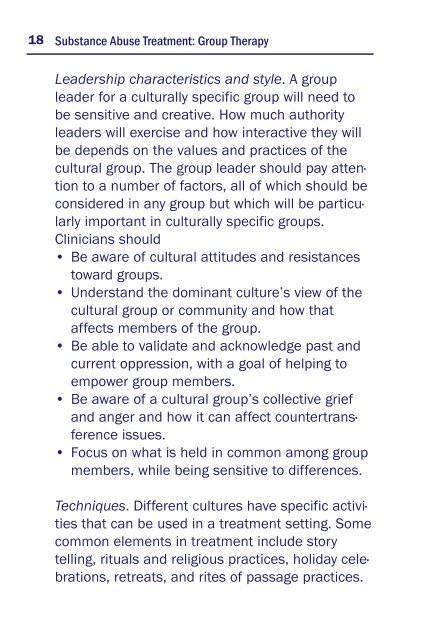Quick Guide for Clinicians - SAMHSA Store - Substance Abuse and ...
Quick Guide for Clinicians - SAMHSA Store - Substance Abuse and ...
Quick Guide for Clinicians - SAMHSA Store - Substance Abuse and ...
You also want an ePaper? Increase the reach of your titles
YUMPU automatically turns print PDFs into web optimized ePapers that Google loves.
18 <strong>Substance</strong> <strong>Abuse</strong> Treatment: Group TherapyLeadership characteristics <strong>and</strong> style. A groupleader <strong>for</strong> a culturally specific group will need tobe sensitive <strong>and</strong> creative. How much authorityleaders will exercise <strong>and</strong> how interactive they willbe depends on the values <strong>and</strong> practices of thecultural group. The group leader should pay attentionto a number of factors, all of which should beconsidered in any group but which will be particularlyimportant in culturally specific groups.<strong>Clinicians</strong> should• Be aware of cultural attitudes <strong>and</strong> resistancestoward groups.• Underst<strong>and</strong> the dominant culture’s view of thecultural group or community <strong>and</strong> how thataffects members of the group.• Be able to validate <strong>and</strong> acknowledge past <strong>and</strong>current oppression, with a goal of helping toempower group members.• Be aware of a cultural group’s collective grief<strong>and</strong> anger <strong>and</strong> how it can affect countertransferenceissues.• Focus on what is held in common among groupmembers, while being sensitive to differences.Techniques. Different cultures have specific activitiesthat can be used in a treatment setting. Somecommon elements in treatment include storytelling, rituals <strong>and</strong> religious practices, holiday celebrations,retreats, <strong>and</strong> rites of passage practices.
















